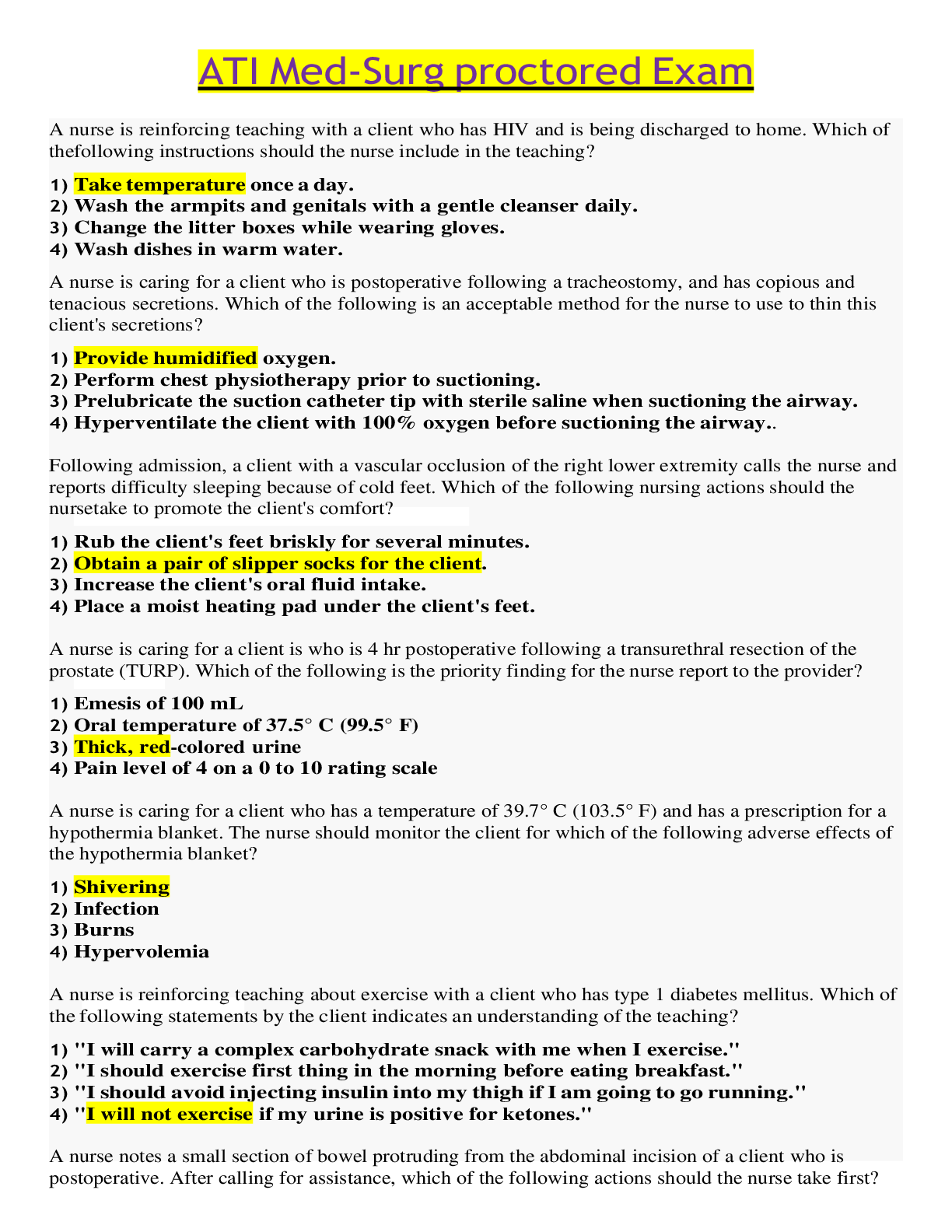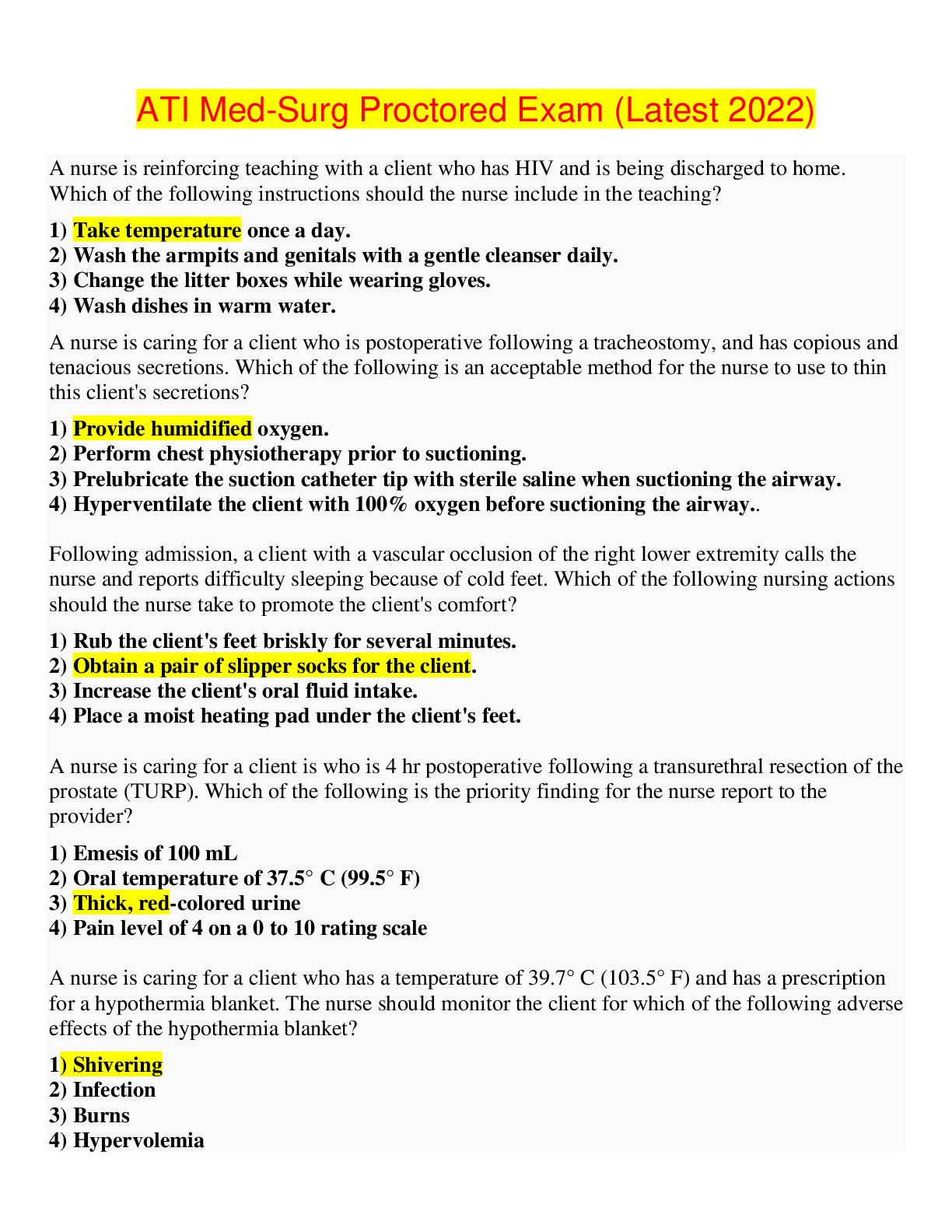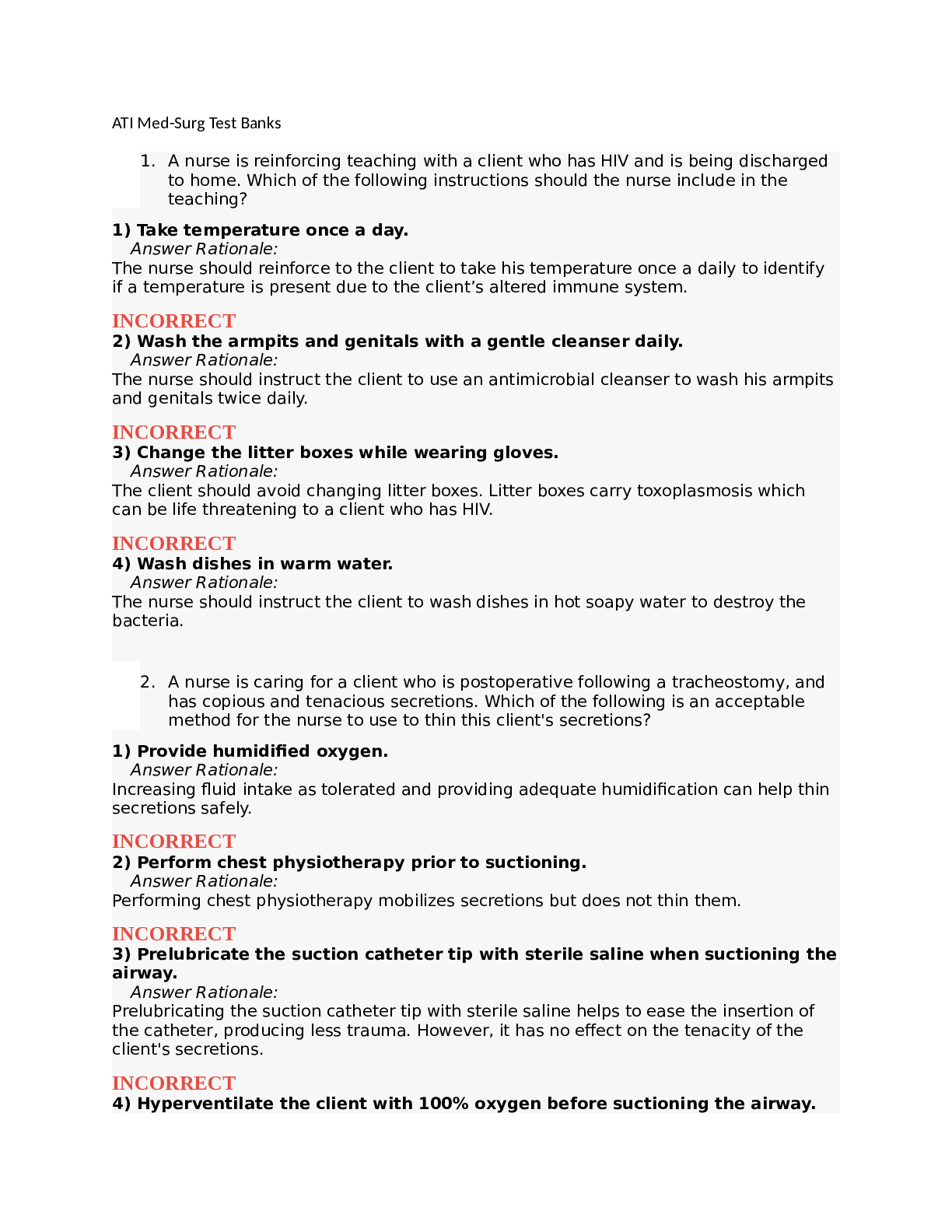*NURSING > ATI MEDICAL SURGICAL > ATI PEDIATRIC Proctored Exam 2021. With Detailed Answers (All)
ATI PEDIATRIC Proctored Exam 2021. With Detailed Answers
Document Content and Description Below
1. A nurse is reinforcing teaching with the parents of preschoolers regarding the use of booster seats in a motor vehicle. Which of the following instructions should the nurse include in the teaching?... 2. A nurse is contributing to the plan of care for a child who is in Buck’s traction. Which of the following interventions should the nurse include in the plan? 3. A guardian calls the clinic nurse after his child has developed symptoms of varicella and asks when his child will no longer be contagious. Which of the following responses should the nurse make? 4. A nurse is caring for a toddler who has otitis media and a temperature of 102.4 F. Which of the following actions should the nurse take first? 5. A nurse is caring for an adolescent who has acne and a new prescription for isotretinoin. For which of the following adverse effects should the nurse monitor? 6. A nurse is contributing to the plan of care for a 10 month old infant who is postoperative following a cleft palate repair. Which of the following actions should the nurse include in the plan of care? 7. A nurse is reinforcing teaching about sudden infant death syndrome (SIDS) with the parent of a 1 month old infant. Which of the following statements by the parent indicates an understanding of the teaching? 8. A nurse is collecting data from an infant during a well-child visit. Which of the following sites should the nurse use when obtaining the infant’s heart rate? 9. A nurse is reinforcing teaching with the guardians of a school-age child who has frequent nosebleeds. Which of the following instructions should the nurse include? 10. During a well-child visit, the parent of a toddler expresses concern to the nurse that the toddler takes several hours to fall asleep at night. Which of the following recommendations should the nurse make? 11. A nurse is caring for a toddler who has terminal cancer and is receiving hospice care. The child’s parent tells the nurse, “I’m a bad parent, and I can’t deal with this.” Which of the following responses should the nurse make? 12. A nurse is reinforcing teaching with the family of an adolescent client who was recently diagnosed with celiac disease. Which of the following foods should the nurse recommend? 13. A nurse is collecting data from a child during a well child visit. The nurse should recognize that which of the following findings places the child at a higher risk for abuse? 14. A nurse is reinforcing dietary teaching with the parent of a 2 year old toddler. Which of the following should the nurse include in the teaching? 15. A nurse is reviewing the plan of care for a child who has cystic fibrosis. Which of the following is the priority goal for this child? 16. A nurse is collecting physical data from a 4 year old child who has diarrhea and has been vomiting for 24 hr. which of the following sites should the nurse grasp to determine the child’s skin turgor? 17. A nurse is collecting data from a 12 month old infant during a well child visit. At birth, the infant’s weight was 3.6 kg (8 lb) and his length was 50.8 cm (20 in). Based on this data, which of the following findings should the nurse expect? 18. A nurse is preparing to leave the room after performing nasal suctioning for an infant who has respiratory syncytial virus (RSV). Identify the sequence in which the nurse should remove the following personal protective equipment (PPE). 19. A nurse is reinforcing teaching with the parent of an infant who has a new diagnosis of HIV. Which of the following statements made by the parent indicates an understanding of the teaching? 20. A nurse is reinforcing teaching about vital signs with the guardian of a 1 year old toddler. Which of the following statements by the guardian indicates an understanding of the teaching? 21. A nurse is reinforcing teaching with an adolescent who has an inflamed, non perforated appendix and is scheduled for a laparoscopic assisted appendectomy. Which of the following instructions should the nurse include in the teaching? 22. A nurse is caring for a 3 year old female child who is prescribed an indwelling urinary catheter. Which of the following actions should the nurse take when performing this procedure? 23. A nurse is preparing to administer furosemide to a toddler who has a heart defect. Which of the following actions should the nurse take to identify the toddler? 24. A nurse is preparing to administer levalbuterol via nebulizer to a child with asthma. Which of the following data should the nurse collect prior to administering the medication? 25. A nurse is reinforcing teaching about liquid oral iron supplements with the guardian of a school-age child who has iron deficiency anemia. Which of the following statements by the guardian indicates an understanding of the teaching? 26. A nurse is reinforcing teaching with the parent of a 4 month old infant who has a new prescription for nystatin to treat oral candidiasis and is breastfeeding. Which of the following instructions should the nurse include in the teaching? 27. A nurse is preparing to administer an intramuscular injection to an 11 month old infant. In which of the following areas should the nurse administer the injection? 28. A nurse if reinforcing teaching with the guardian of a school age child who has acute bacterial conjunctivitis and a new prescription for sulfacetamide. Which of the following instructions should the nurse include? 29. A nurse is caring for a 1 month old infant who has a nasogastric tube in place for intermittent feedings. Which of the following actions should the nurse take? 30. A nurse is collecting data from a school age child. The nurse should identify that which of the following findings is a manifestation of physical abuse? 31. A nurse is preparing to obtain a peak expiratory flow rate from an adolescent. Which of the following actions should the nurse take? 32. A nurse is collecting data from an 18 month old toddler. Which of the following is a deviation from expected growth and development that the nurse should report to the provider? 33. A nurse is assisting with the care of a 4 year old child who is prescribed an IV medication preoperatively. Which of the following techniques should the nurse use to assist the child to cope with this procedure? 34. A nurse is preparing to assist a provider with a lumbar puncture for a school age child. Which of the following actions is the nurse’s priority? 35. A nurse is reinforcing discharge teaching with the guardians of a 6 month old infant following a surgical procedure to repair a hypospadias. Which of the following instructions should the nurse include? 36. A nurse is reinforcing teaching regarding the immunization schedule with the parent of a 6 month old infant during a well-baby visit. Which of the following statements by the parent indicates an understanding of the teaching? 37. A nurse is assisting with the care of a child who is postoperative and received a transfusion during a surgical procedure. Which of the following findings indicate the child is having a hemolytic reaction? 38. A nurse is collecting data from a 10 month old infant. Which of the following findings should the nurse report to the provider? 39. A nurse is reinforcing teaching with the guardian of a child who has a new prescription for levalbuterol solution for use in a nebulizer. Which of the following statements by the guardian indicates an understanding of the teaching? 40. A nurse is assisting with the care for a 7 month old infant who has a cleft palate. Which of the following actions should the nurse take to decrease the infant’s risk for aspiration? 41. A nurse is reinforcing teaching with the parent of a school age child who has lactose intolerance. Which of the following supplements should the nurse instruct the parent to include in the child’s diet? 42. A nurse is reinforcing teaching with the parents of a 2 year old toddler at a well child visit. Which of the following should the nurse recommend as an age appropriate activity for the toddler? 43. A nurse is reinforcing teaching about interventions for mild hypoglycemia with the parent of a child who has diabetes mellitus. Which of the following statements by the parent indicates that the teaching has been effective? 44. A nurse is reinforcing teaching about home care with the guardian of a 14 month old toddler who has spastic cerebral palsy. Which of the following statements by the guardian indicates and understanding of the teaching? 45. A nurse is reinforcing dietary teaching with an adolescent who is a lacto-vegetarian and has iron deficiency anemia. The nurse should recommend which of the following as the best source of iron? 46. A nurse is caring for a toddler following a tonsillectomy. Which of the following is the priority finding that the nurse should report to the provider? 47. A nurse is administering an injection of epinephrine to a child who is experiencing manifestations of anaphylaxis. The nurse should monitor for which of the following adverse effects? 48. A nurse in a provider’s office is caring for a preschooler who has findings of croup. Which of the following statements by the parent requires immediate intervention by the nurse? 49. A nurse is preparing a toddler for suturing of a minor facial laceration. The nurse should place the toddler in which of the following restraints? 50. A nurse is reinforcing teaching with the guardian of a child who has a new diagnosis of rheumatic fever. Which of the following statements by the guardian indicates an understanding of the teaching? My child might have a period of irregular movement of the extremities—the child might experience chorea weeks or months after the initial diagnosis. Chorea is a temporary lack of coordination and the presence of sudden, irregular movements or period of clumsiness. 51. A nurse is assisting with the development of a health promotion program for the guardians of adolescents. Which of the following information about adolescents should the nurse recommend to include in the program? The leading cause of death in adolescents is physical injury—injuries from motor vehicle crashes are the leading cause of death in the adolescent population. 52. A nurse is reviewing the laboratory values of a school age child who has iron deficiency anemia. Which of the following findings should the nurse expect? Hgb 9.0 g/dL—a child who has iron deficiency anemia to have an Hgb level below the expected reference range of 9.5 to 15.5 g/dL. An Hgb of 9.0 g/dL is below the expected reference range. 53. A nurse is caring for a child who has type 1 diabetes mellitus and has been receiving insulin via subcutaneous infusion pump. Which of the following laboratory tests would verify the average blood glucose level over the past 2 months? Glycosylated hemoglobin—provides an accurate average of the client’s blood glucose level over the past 120 days. This test can be used to determine the effectiveness of, or compliance with, a treatment plan. It can also be used to diagnose diabetes mellitus. 54. A nurse is reinforcing teaching with the parent of a child who is being treated with diphenhydramine for allergic rhinitis. The nurse should tell the parent to monitor the child for which of the following? Drowsiness—diphenhydramine can cause drowsiness due to CNS depression. The nurse should reinforce with the parent to administer the medication at bedtime to avoid daytime sedation. 55. A nurse in a pediatric clinic is talking on the telephone with the parent of a 6 month old infant who has a urinary tract infection and started taking an oral antibiotic the day before. Mix the medicine with 1 teaspoon of applesauce before giving it to your baby—to enhance acceptance of an oral medication, the parent can mix the medication with a small amount of a sweet, nonessential food item. 56. A nurse in a pediatric clinic is caring for an infant who has heart failure and a prescription for digoxin. Which of the following statements by the parent indicates the desired therapeutic effect of the medication? My baby is breathing easier than she used to—the desired effect of digoxin is to increase cardiac output and decrease venous pressure and pulmonary edema, which will reduce respiratory demands. 57. A nurse is collecting data from an 18 month old toddler who has just presented to the urgent care clinic. Which of the following data should the nurse investigate further? Blood pressure 120/80 mm Hg—is outside the expected reference range for an 18 month old toddler. 58. A nurse is reinforcing anticipatory guidance to the parents of an adolescent. Which of the following recommendations should the nurse include? Be open to the adolescent’s point of view—adolescents are developing autonomy and self-identify. The nurse should recommend that the parents actively listen and be open to the adolescent’s point of view, even if the parents disagree with his viewpoint. 59. A nurse is preparing to administer phenobarbital to a toddler who has a seizure disorder and weights 10 kg (22 lb). The prescription reads phenobarbital sodium 2.5 mg/kg PO BID. Available is phenobarbital 20 mg/5mL. How many mL should the nurse administer with each dose? 6.25 mL 60. A nurse is assisting with the admission of a toddler who has bacterial meningitis caused by haemophilus influenzae type B. which of the following isolation guidelines should the nurse plan to initiate? Droplet precautions—it is transmitted thought the air via large particle droplets [Show More]
Last updated: 10 months ago
Preview 1 out of 8 pages
.png)
Reviews( 0 )
Document information
Connected school, study & course
About the document
Uploaded On
Aug 07, 2021
Number of pages
8
Written in
Additional information
This document has been written for:
Uploaded
Aug 07, 2021
Downloads
0
Views
175

.png)
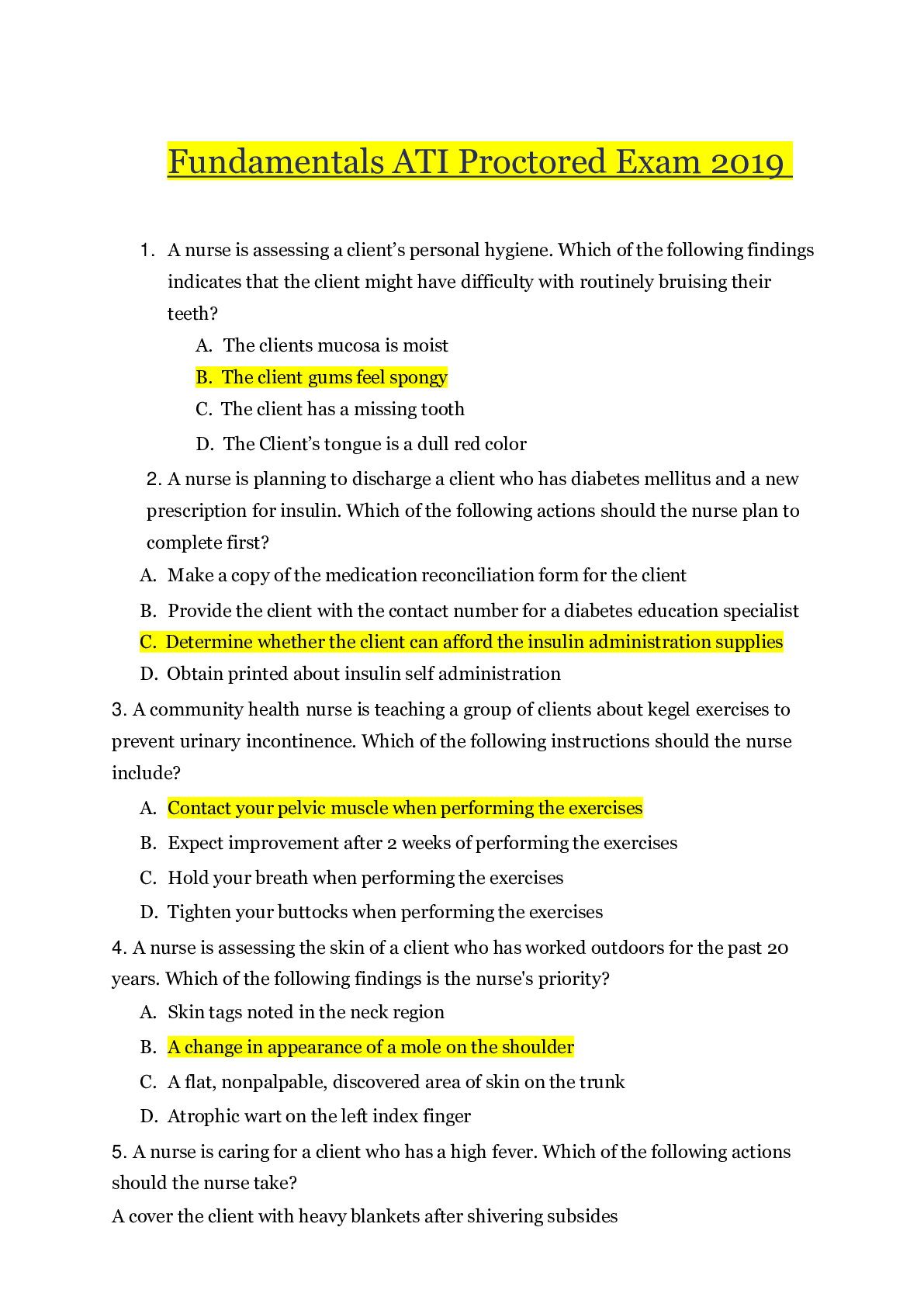
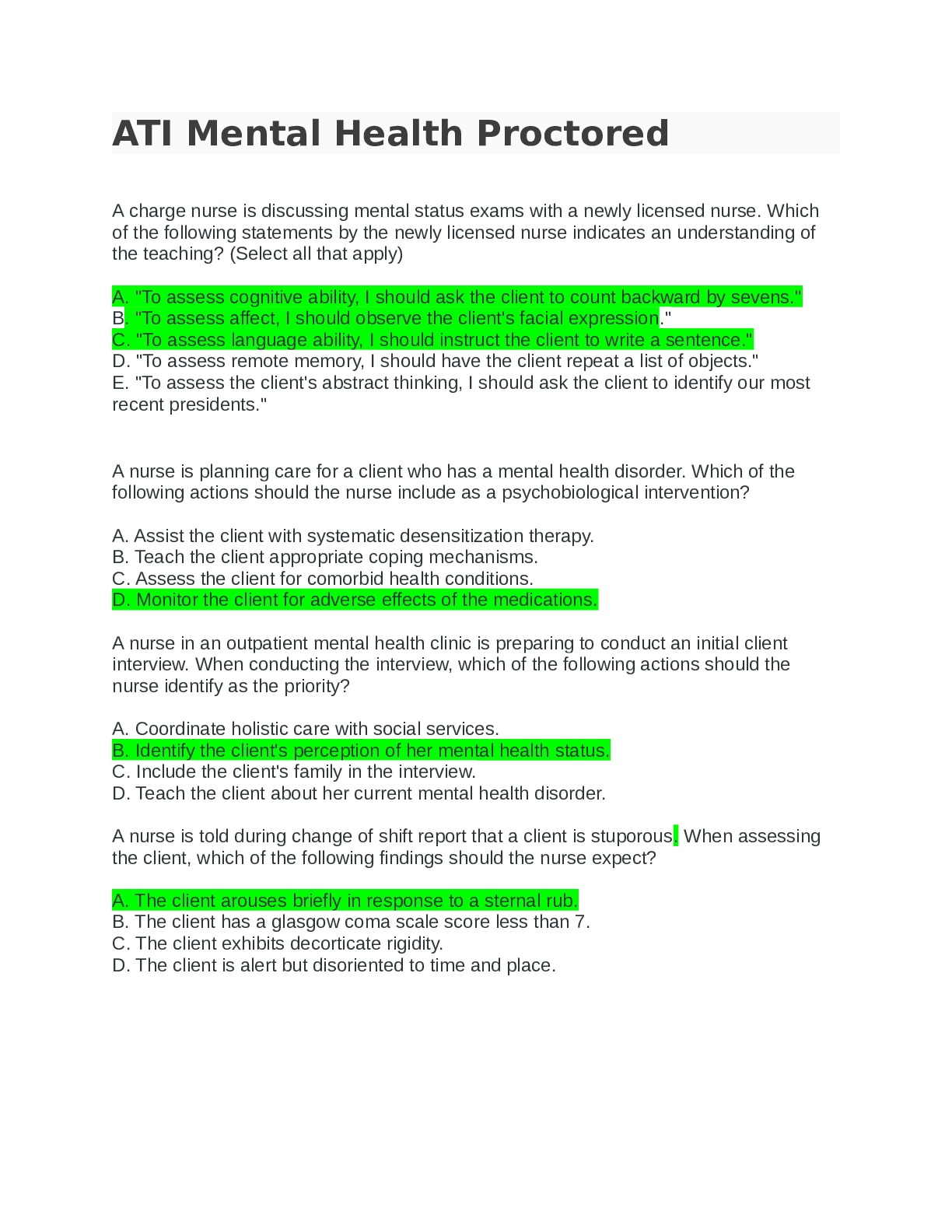
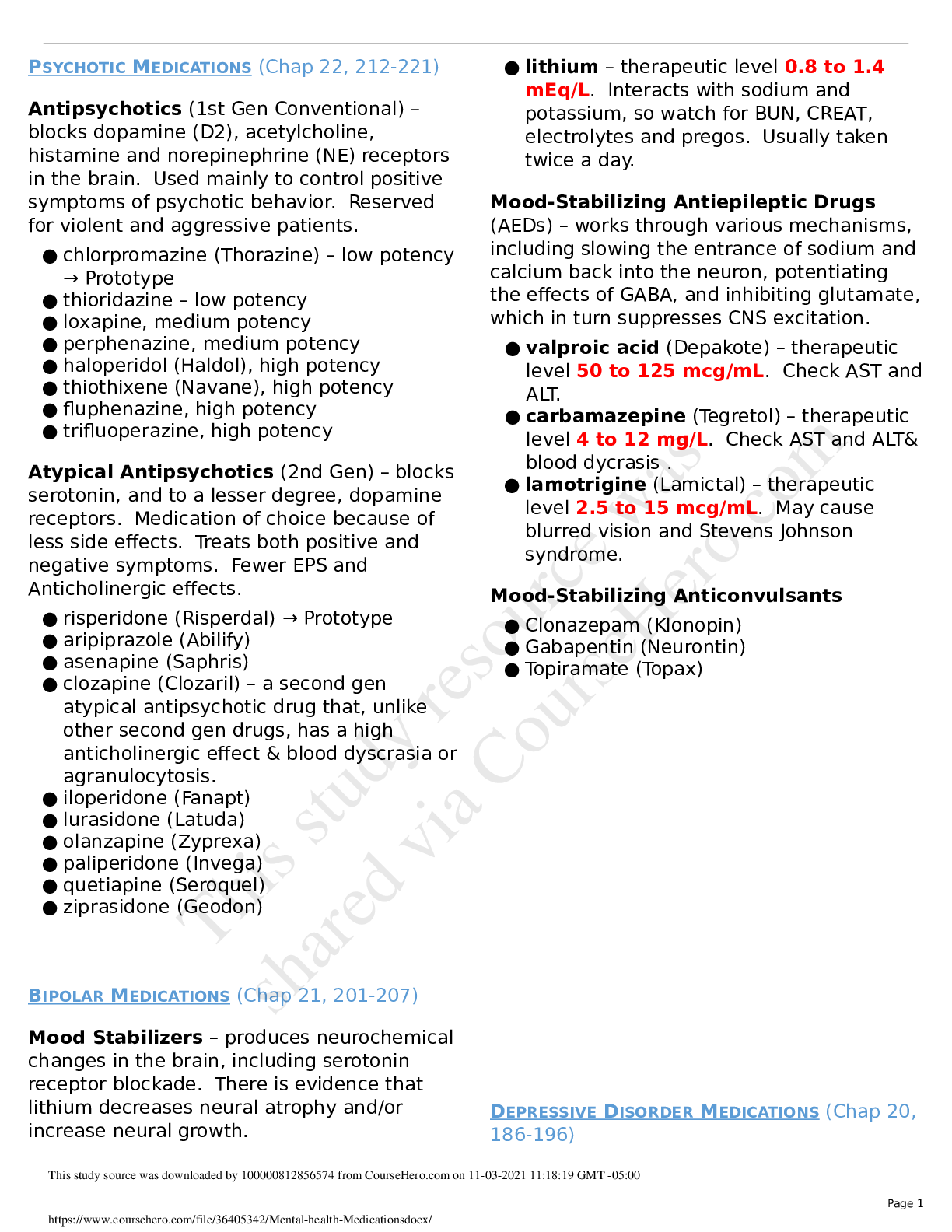

 Correct Answers, Download to Score A.png)
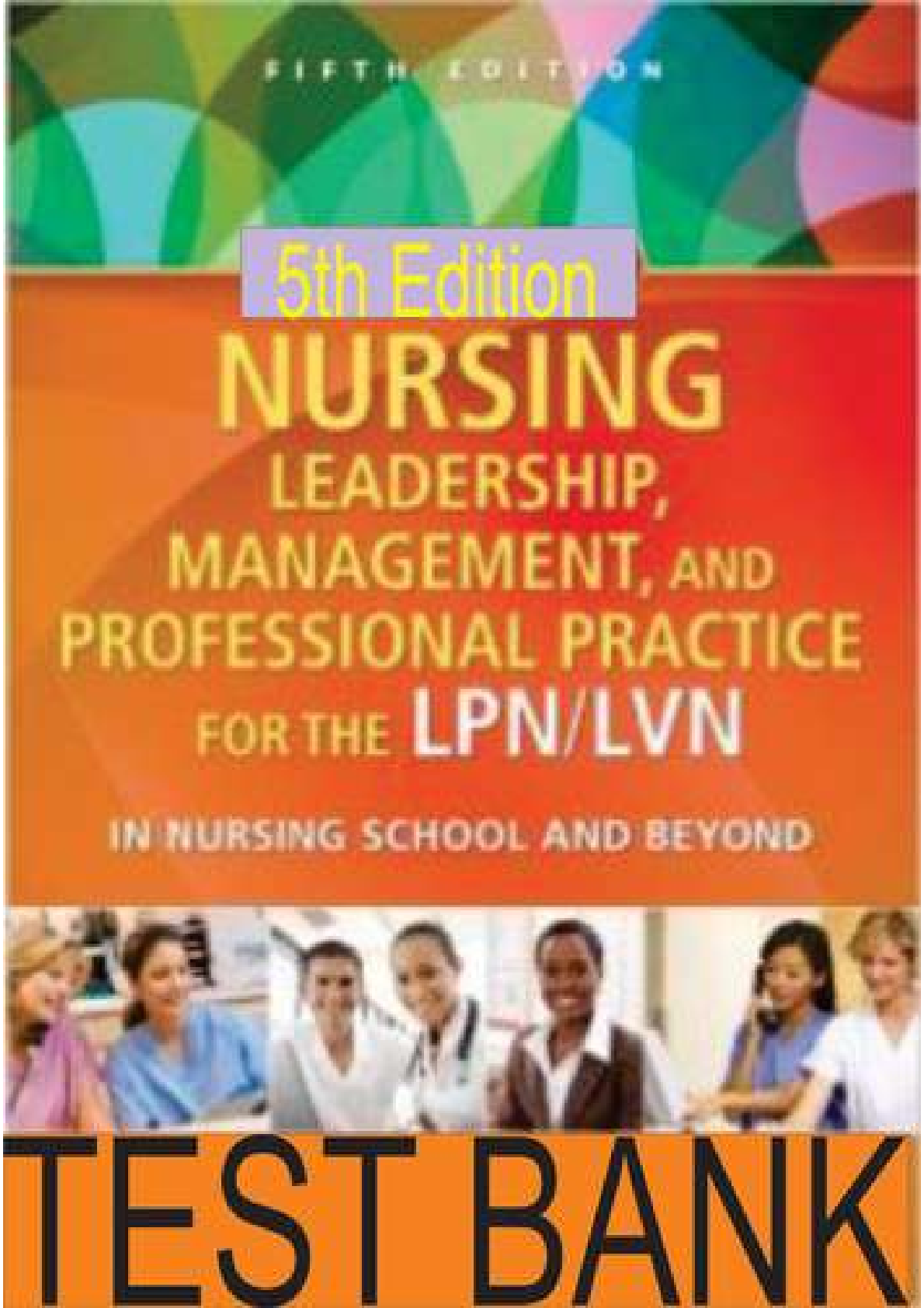
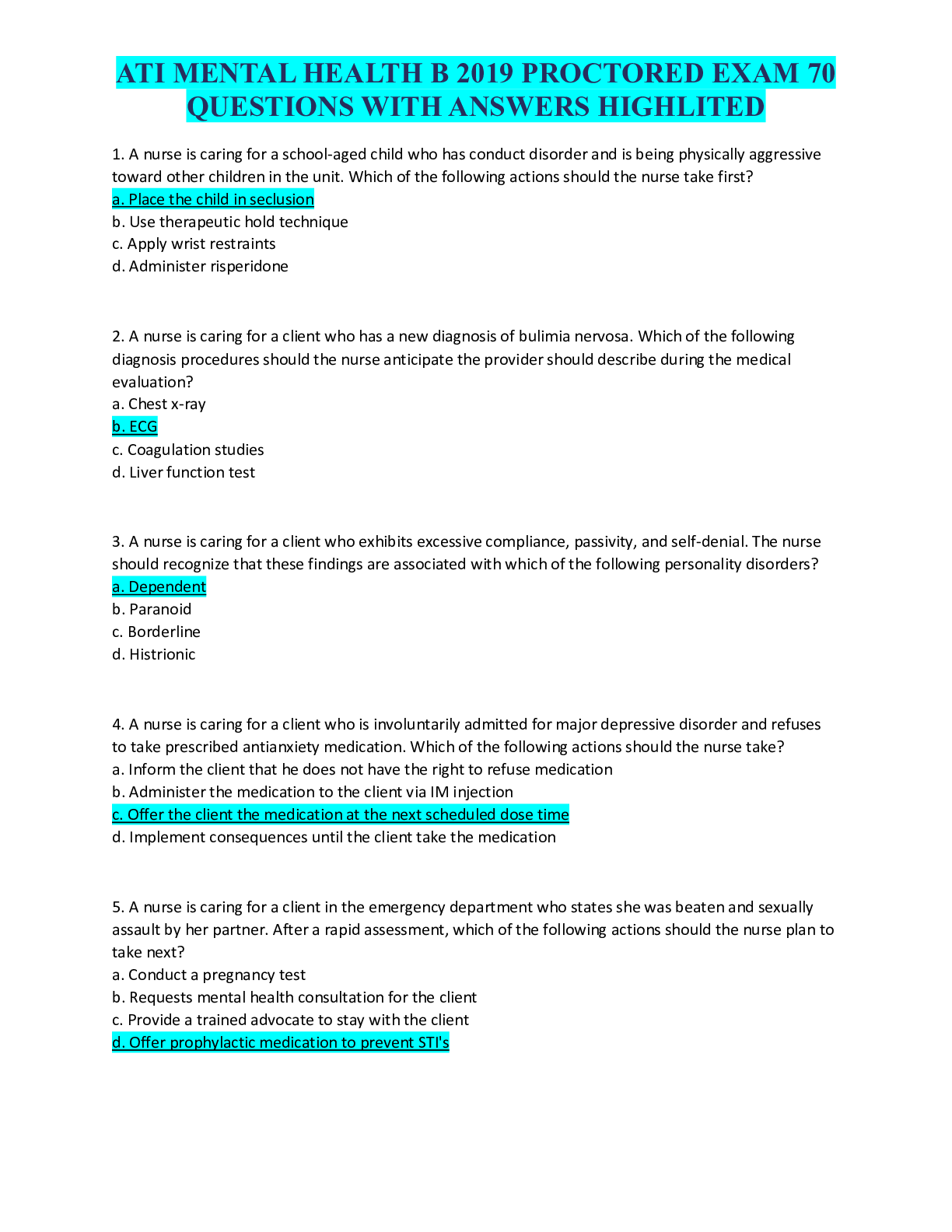
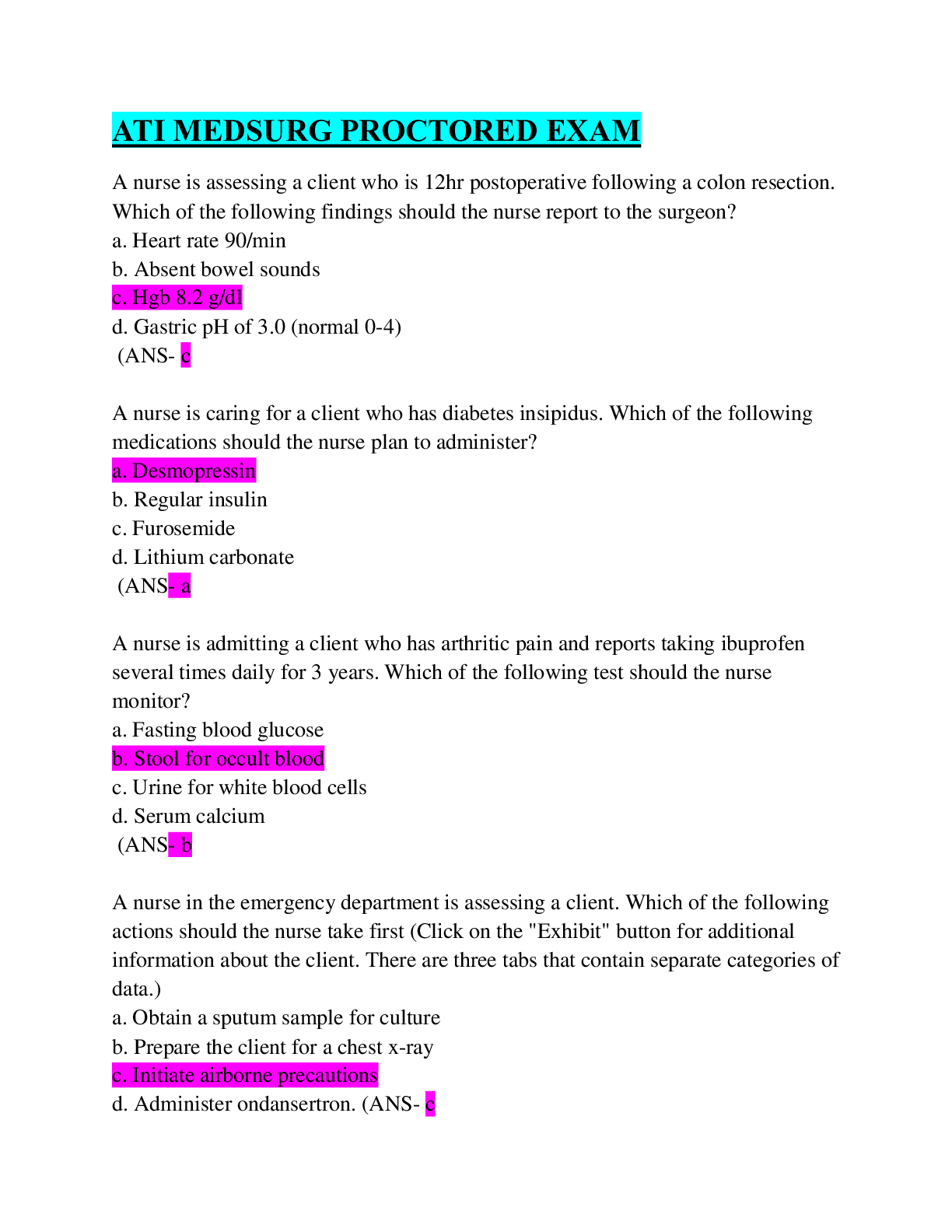
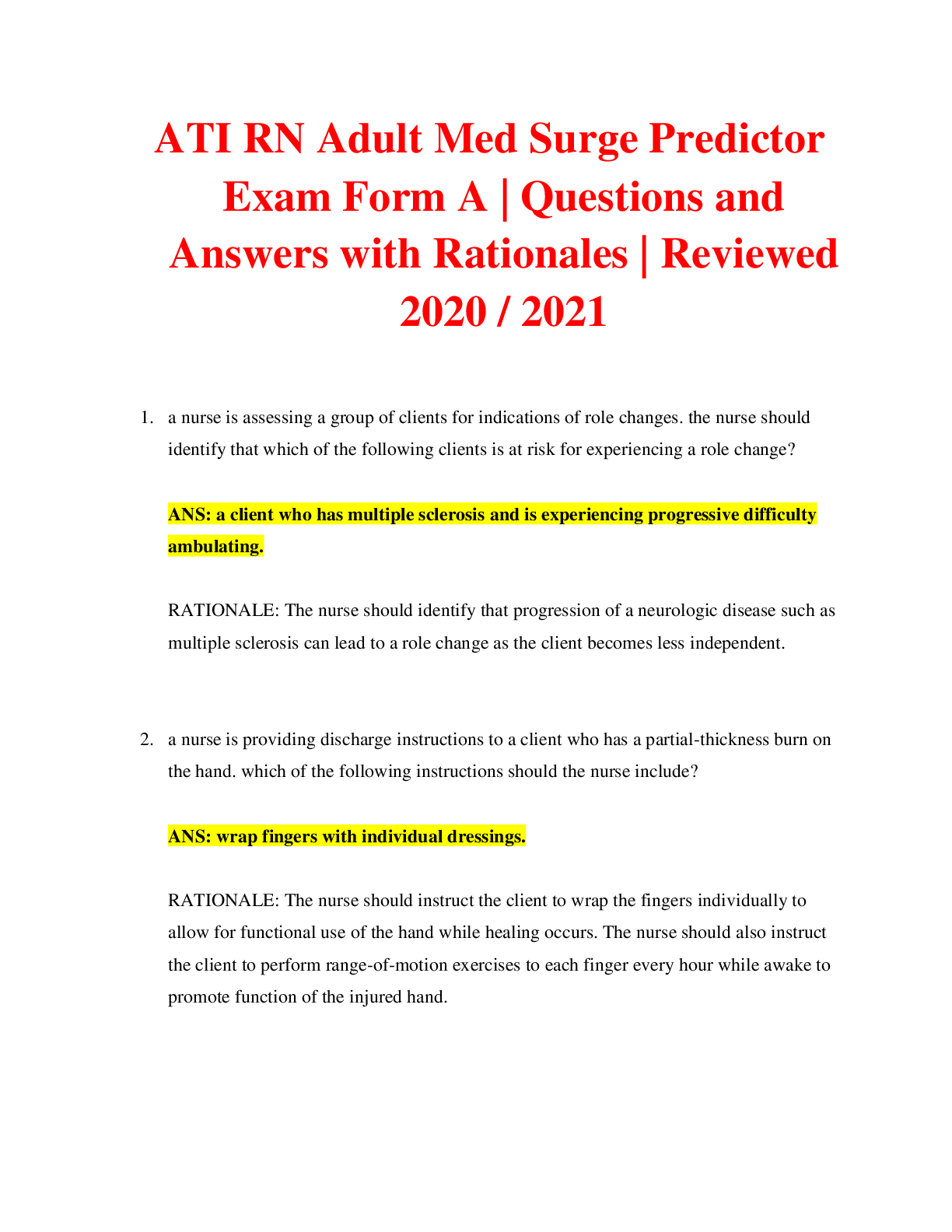
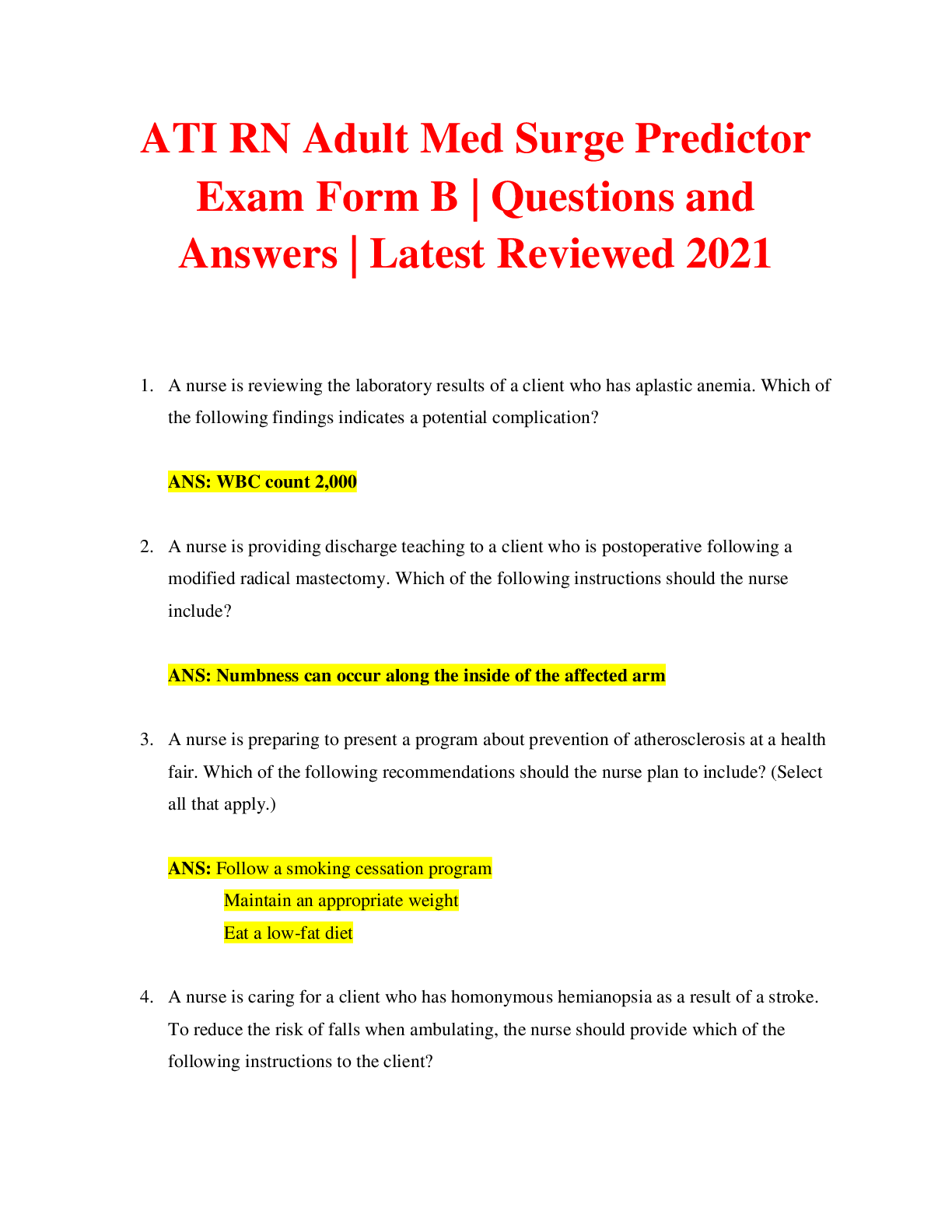
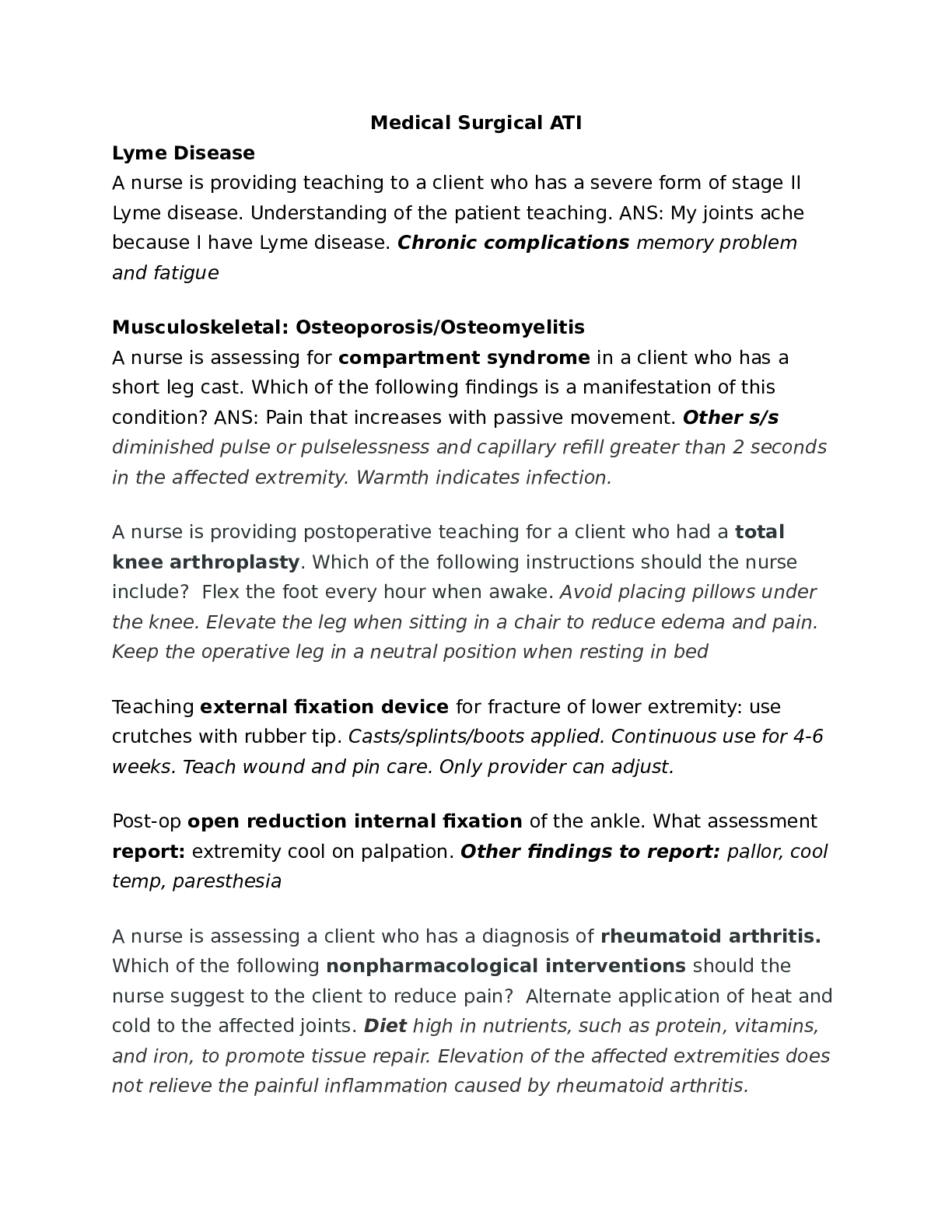
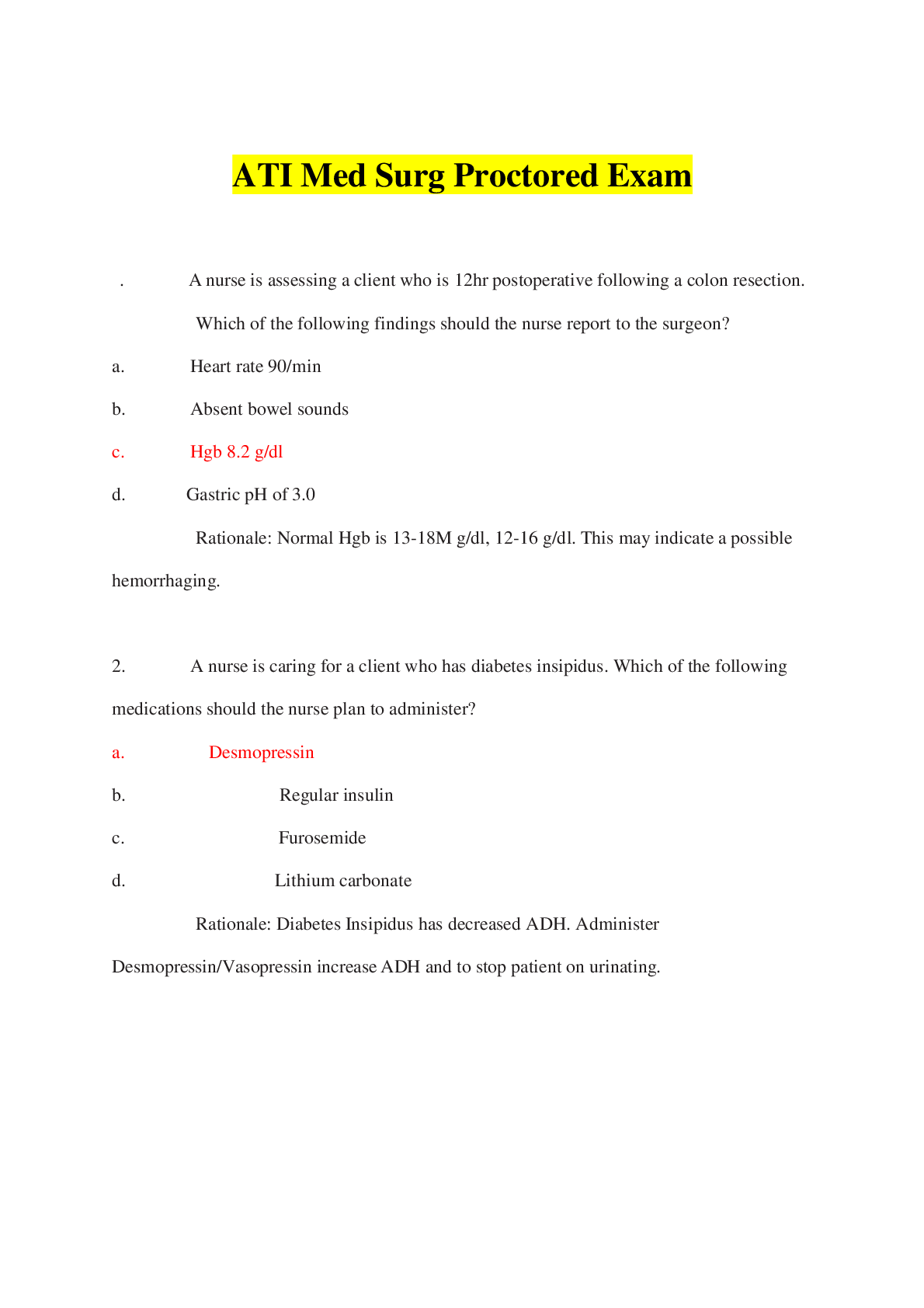
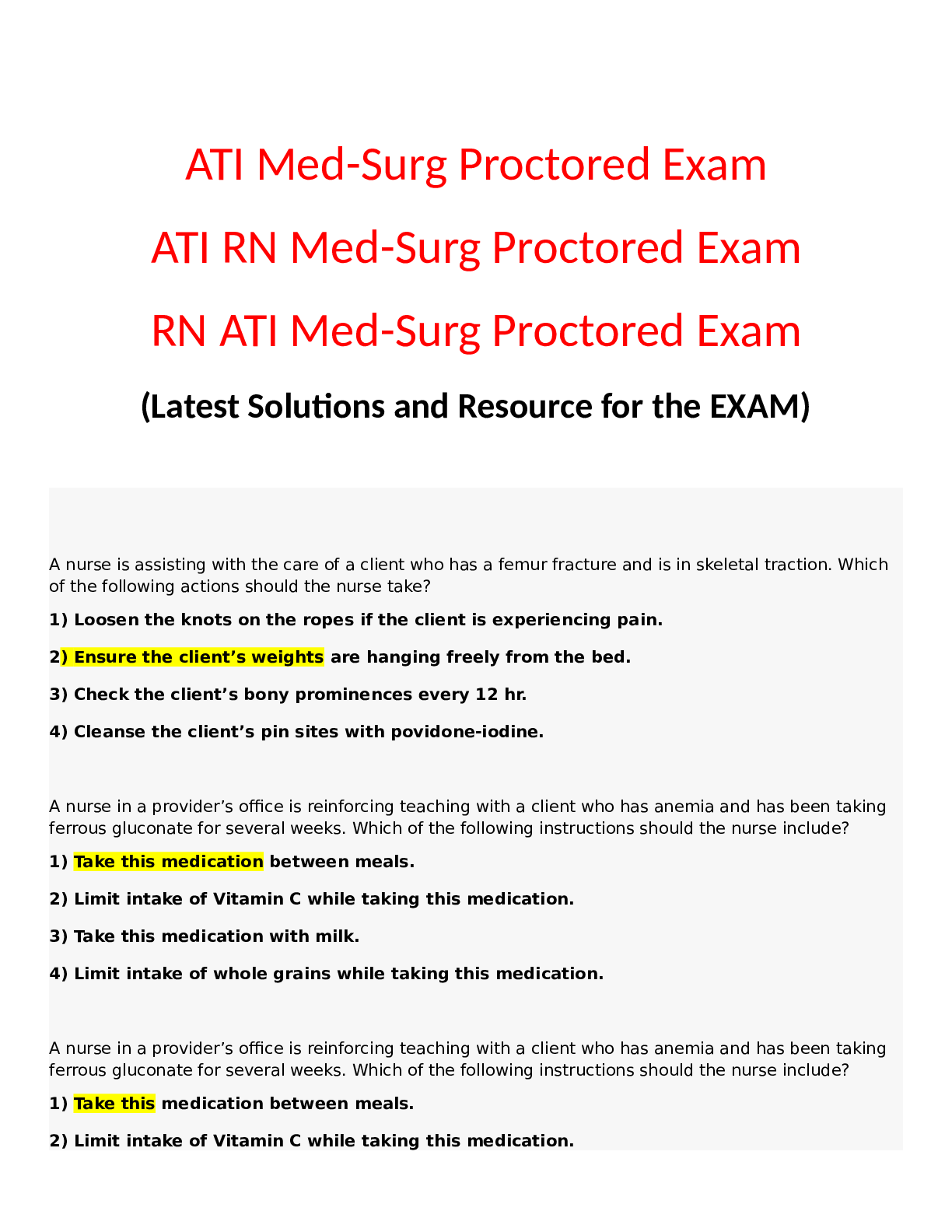
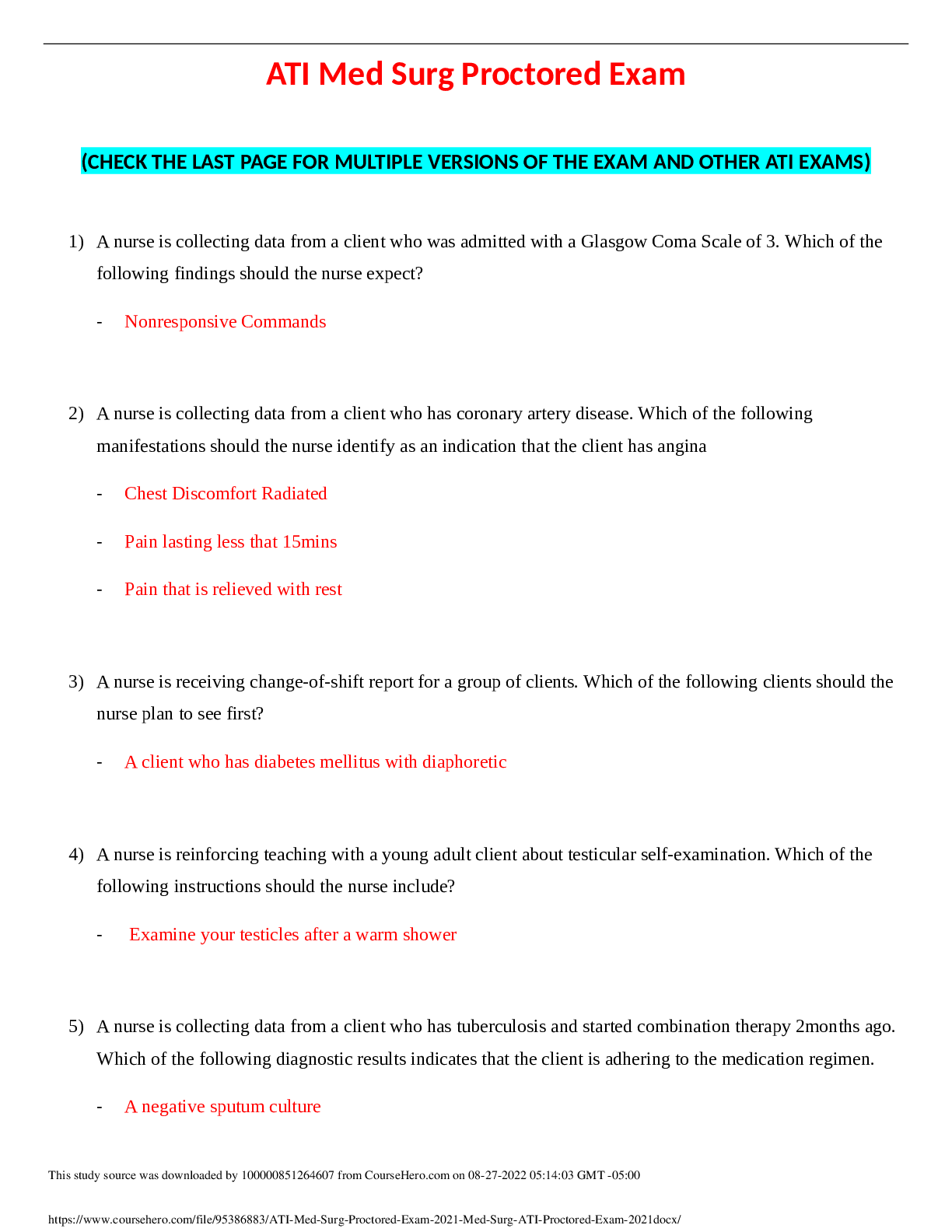
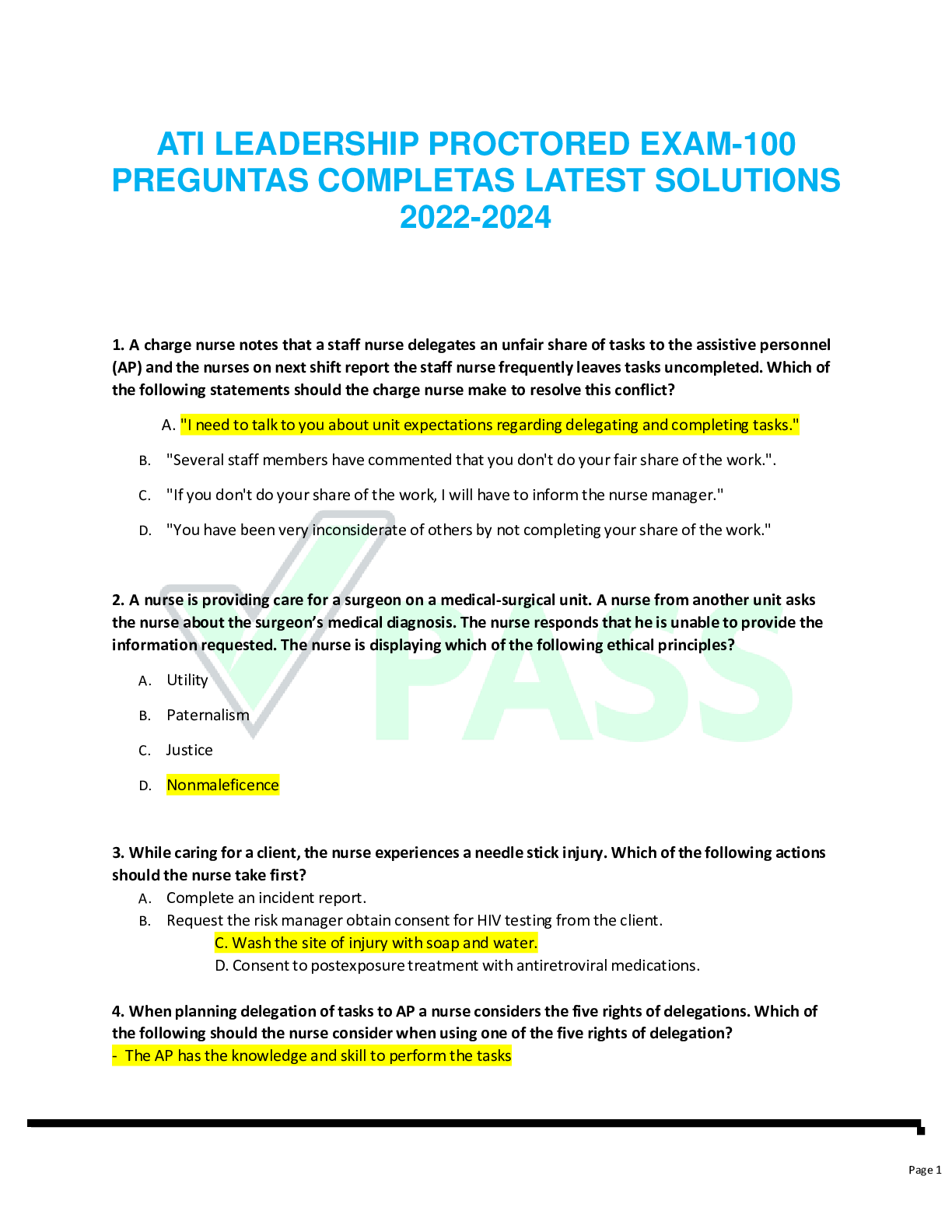



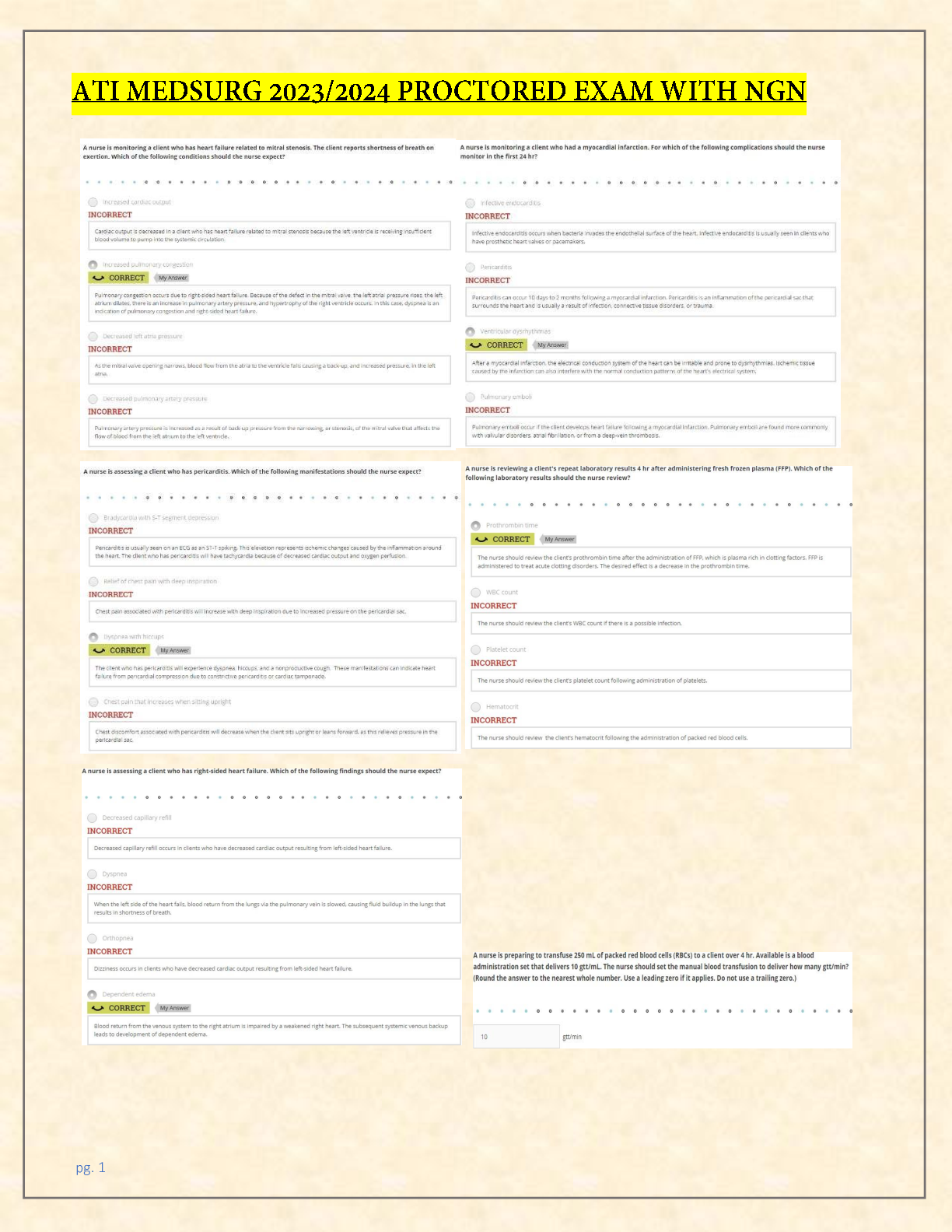
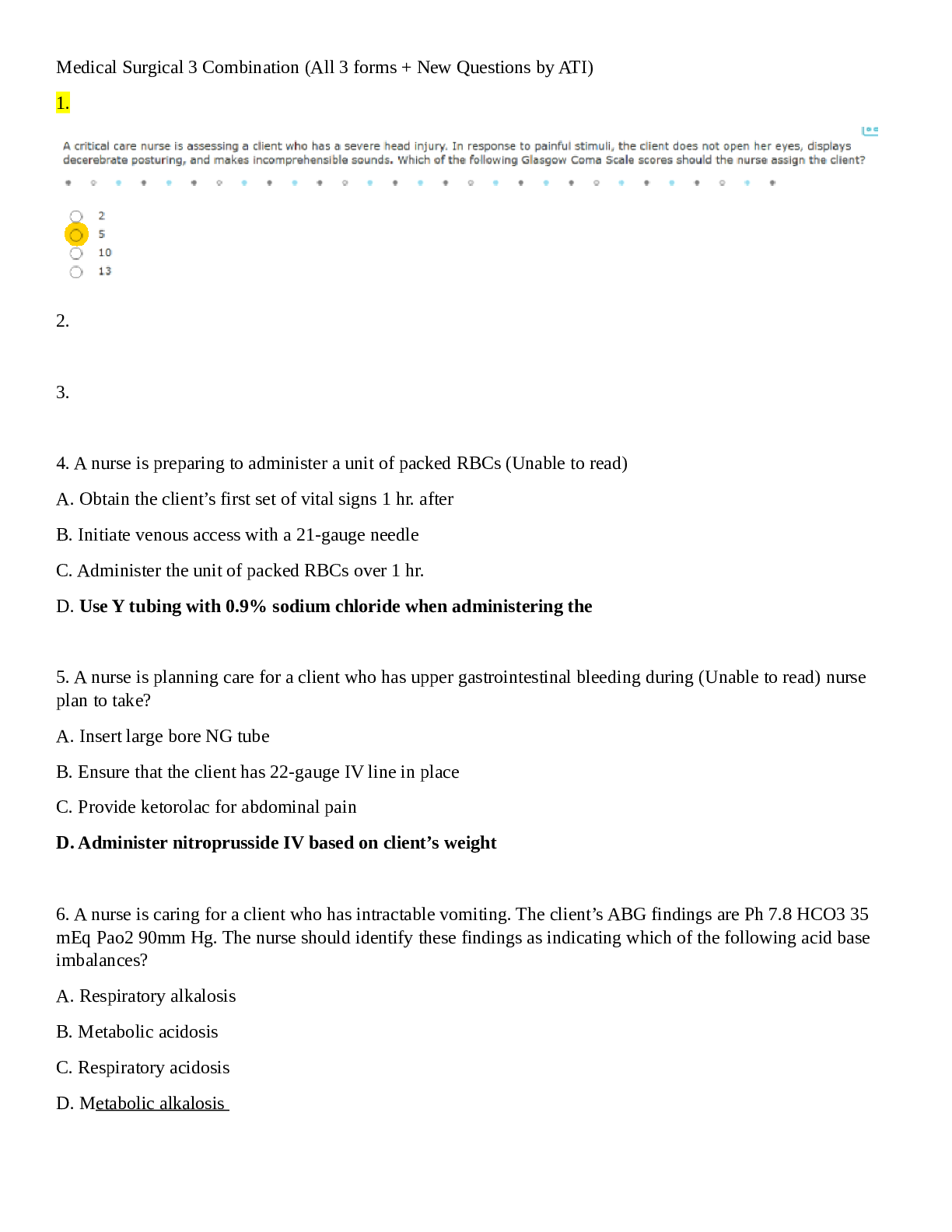
 – Chamberlain College of Nursing.png)
